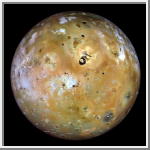Io

-
- Voyager 1 identified nine currently
active (erupting) volcanoes on Io, probably driven by tidal heating. Many more are
suspected. Voyager 2 observed eight of the nine; the largest shut down by the time Voyager
2 arrived at Jupiter. Plumes from the volcanoes reach more than 300 kilometers (190 miles)
above the surface. The material was being ejected at velocities up to 1.05 kilometers a
second (2,300 miles an hour). By comparison, ejection velocities at Mount Etna, one of
Earth's most explosive volcanoes, hit 50 meters a second (112 miles an hour). Volcanism is
associated with heating of Io by tidal pumping. Europa and Ganymede, two large satellites
nearby, perturb Io in its orbit and Jupiter pulls Io back again. The pumping action causes
tidal bulging up to 100 meters (330 feet) on Io's surface, compared with typical tidal
bulges on Earth of one meter (three feet).
- Voyager 1 measured the temperature of a
large hot spot on Io associated with a volcanic feature. While the surrounding terrain has
a temperature of about 130 Kelvins (-230 degrees Fahrenheit), the hot spot's temperature
is about 290 Kelvins (60 degrees Fahrenheit). Scientists believe the hot spot may be a
lava lake, although the temperature indicates the surface is not molten; it is, at least,
reminiscent of lava lakes on Earth.


![]()